Biography
“It comes down to the fact that I managed to get hold of a camera, a Leica, and I just wanted to… but wait, why should I be telling all this? I am a photographer, period.”
Quote from Leonore Mau from the interview with Ingo Niermann, 2005 | To the interview with Ingo Niermann
1916
Leonore Maria Lucilla Burckas is born in Leipzig on the 1st August.
1934
She studies stage design at the Academy of Visual Arts in Leipzig.
1937
Leonore Burckas marries the architect Ludwig Mau.
The marriage produces two children: son Michael Mau and daughter Ulrike Bahrmann.
1945
The family flees to Hamburg (Blankenese).
1950
Leonore Mau meets Hubert Fichte at a literary jour-fixe hosted by her husband.
1950s
She trains as a press photographer with Wolfgang Etzold.
First camera of her own: a used Leica IIIf with an Elmar lens.
During these years she photographs the port of Hamburg, scenes that focus architecture or street life as well as portraits of family and acquaintances. This period was followed by first publications in the Hafen Rundschau and commissions for architectural photographs.
Acquires a second camera: Rolleiflex
1962
In March: Leonore Mau visits Hubert Fichte and the painter Serge Fiorio in Montjustin.
1963
Leonore Mau and Hubert Fichte move into a shared flat in Dürerstrasse 9 in Hamburg, where she continues to live until the end of her life.
1964/65
Several trips through Europe follow. She photographes in Finland and Denmark, among other places.
She takes architectural photographs for the magazine Architektur und Wohnform (including the home of the interior – and furniture designer Eero Aarnio).
Leonore Mau begins during this time to take portraits of well-known personalities from the visual arts and literature, e.g. the writers Elfriede Gerstl, Christa Reinig and Ingeborg Bachmann.
The three-month stay (1964) in the Portuguese fishing village of Sesimbra was the first long stay abroad with Hubert Fichte. Here she shot the photo film Der Fischmarkt und die Fische.
1966
Further trips to the European continent follow, e.g. to Greece.
Shots are taken of the port of Hamburg for the photo film Der Tag eines unständigen Hafenarbeiters.
1967/1968
Shoots are taken in Rome for the photo film Die Spanische Treppe and portraits of scholarship holders at the Villa Massimo, where Hubert Fichte stays for several months, including the poet Peter Rühmkorf and the painter Karl Horst Hödicke.
1969
Together with Hubert Fichte, Leonore Mau travels to Brazil and Egypt for several months.
She takes photographs of the favelas and different architectures, including the Brasília Cathedral (Catedral Metropolitana Nossa Senhora Aparecida) by the architect Oscar Niemeyer.
In Egypt, she documented the damaged Egyptian Museum in Cairo. Published in DER SPIEGEL (22nd of December 1969, no. 52) and DIE ZEIT (15th of May 1970, no. 20). Photographs of children in Egypt are published in Die Kinder Herodots. Publications of her photographs from Brazil follow in the “Stern” (Urlauber, kommst du nach Rio…, 30th of March 1969).
1970
Shoots are taken in Agadir (Morocco) for the photo film Zwei Mal 45 Bilder / Sätze aus Agadir.
1971
Leonore Mau and Hubert Fichte travel to Salvador da Bahia (Brazil) and Santiago de Chile (Chile). Here she takes pictures for the picture book Xango, pictures of Candomblé rituals as well as pictures of the Chilean President Salvador Allende.
1972 – 74
Leonore Mau and Hubert Fichte travel to Haiti, Martinique, Grenada, Trinidad and the Dominican Republic as well as for the first time to Dakar (Senegal) to visit the psychiatric villages there.
Photographs are taken for the picture books Xango and Psyche.
The Brazil photographs are published in DER SPIEGEL (Ein Geschwür bedeckt das Land. Furcht und Elend der brasilianischen Republik (1. & 2. Teil), 24th & 31th of January 1972).
Her Caribbean photographs are published in Stern (Wudu – Rendezvous mit den Gesitern, 31th of January 1974).
1975
Leonore Mau and Hubert Fichte travel to Benin, Mexico and New York City (USA). At the bank holidays in Mexico City, photographs are taken of Willy Brand, among others.
In Benin, Leonore Mau takes one of her most famous photographs: “Afrikanischer Junge mit Blister-Maske”. (African Boy with Blister Mask.)
1976
During another stay in Senegal, she takes photographs of the psychiatric village “Village Émile Badiane” of Kenia in Ziguinchor in Casamance, which are published in the picture book Psyche, as well as photographs of the artist Papisto Boy and his murals.
1977 – 1980
Leonore Mau and Hubert Fichte travel to El Tigre, Caracas (Venezuela), Grenada and Togo as well as to Miami and New York in the USA. She takes photographs of Santería rituals and of rituals of the Spiritual Baptists as well as pictures which are later published in the picture book Petersilie.
1981/82
From May Hubert Fichte and Leonore Mau travel to São Luís do Maranhão (Brazil) for a one-year stay. Here she takes photographs of the priestesses of the Casa das Minas and the Candomblé rituals.
1985
Leonore Mau and Hubert Fichte travel again to Fann in Dakar (Senegal) to visit the psychiatric village.
1986
Leonore Mau’s life and work partner Hubert Fichte dies on the 8th of March in Hamburg.
1987 – 1999
Leonore Mau travels alone to India and several times to Portugal. Here she creates her mourning pictures after Fichte’s death.
During these years, she also produces her photographs for the picture book Ensemble of the “Tanztheater Pina Bausch” in Wuppertal.
Around 2004
In Hamburg, Leonore Mau dedicates herself to photographs of still lifes and objects trouvés, including masks and sculptures, which she and Hubert Fichte had collected on their travels. The result is a series of photographs entitled: Fata Morgana.
2013
Leonore Mau dies in Hamburg on the 22nd of September.
Untitled (Self-portrait with Leica), c. 1954
© bpk / S. Fischer Foundation / Leonore Mau
Stamps on the reverse of an original print
© Nathalie David
Untitled (Leonore Mau on the train), 1963
© bpk / S. Fischer Foundation / Hubert Fichte
Untitled (Leonore Mau in the restaurant), 1971/72
© bpk / S. Fischer Foundation / Leonore Mau
Pocket diary of Leonore Mau, 1977
© bpk / S. Fischer Foundation / Leonore Mau
Untitled (Self-portrait with Leica), 1980
© bpk / S. Fischer Foundation / Leonore Mau
Untitled (Portrait of Leonore Mau), 1990
© Margit Tabel-Gerster
Untitled (Self-portrait of Leonore Mau), 2007
© bpk / S. Fischer Foundation / Leonore Mau










